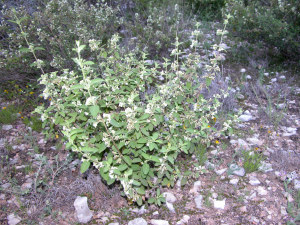Mexican Oregano, Oregano Cimarrón, Hierba Dulce
Lippia graveolens H.B.K.
Verbenaceae (Vervain Family)
There are many common names for this tenacious little shrub, including Mexican oregano, oregano cimarrón, hierba dulce, and redbrush lippia to name a few. Mexcian oregano grows in abundance on rocky slopes along the southwestern edge of the Edwards Plateau and Mexico south to Durango, and its range extends west from the coastal plain to the Trans-Pecos (Correll and Johnston 1970). The small, deciduous leaves will drop in the winter or during extreme drought, but this hardy plant will bounce back with the slightest rainfall. It has dietary and medincal uses.
Archeological occurrence. Lippia graveolens has not been recovered from archeological sites. This is not surprising, since the leaves are the only parts of the plant that are know to be utilized, and leaves are usually only recovered from dry rockshelters.
Chemistry. Although it has been studied for decades, Mexican oregano has recently received increased worldwide attention for it phytochemical contents. As suggested by the aromatic leaves, it contains an abundance of flavonoids, secondary plant metabolites known for their antioxidant activity. Flavanones recovered from the plant include narengenin and cirsimaritin, and derivatives of cachetin and quercitine, which are found in green tea and citrus (Gonzalez-Guereca et al. 2006).
Food. Like its namesake oregano (Origanum vulgare) , an Old World plant widely used in New World cuisine, Mexican oregano is utilized as a spice throughout Mexico. The Mexican Kickapoo still use the plant in their cooking (LaTorre and LaTorre 1977). The leaves are dried, stored and utilized as a potherb. The flavor complements many dishes including pinto beans and soups.
The Tarahumara used the leaves as flavoring to pinole, a ground meal made of toasted and ground maize (corn) kernels. Pinole also refers to the drink made of parched cornmeal, hot water, and other additives (such as Mexican oregano). They also make a cornmeal mush (esquiate) in which Mexican oregano is a commonly used condiment (Pennington 1963:76).
The Tarahumara also gather and utilize the plant as a quelite, or fresh green, much as we would use spinach (Pennington 1963:127). In this application green stems and leaves are boiled, drained, and eaten with beans. They also use the leaves to prepare morcilla, a dish made from the large intestine of the pig and coagulated pig's blood. Morcilla refers to "black pudding" or coagulated blood sausage. The blood collected from the pig is mixed with the Mexican oregano leaves and boiled until it is thick. The mass is allowed to cool, poured into the intestine, cooked again, the allowed to cool. It is then sliced and fried for dinner (Pennington 1963:145).
The Tepehuan made a pinole similar to the Tarahumara, but with several greens including Mexican oregano. They also added ground up Nothoscordum bivalve a plant commonly referred to in Texas as crow poison or false garlic. Mexican oregano was also a major constiuent of Esquiate (the mush), which was made with a more complex recipe than the Tarahumara version. The Tepehuan also cooked a pozole as well as a wheat esquiate with the leaves of Mexican oregano. Cattle are slaughtered and the blood is collected to prepare a coagulated blood dish with the leaves of Mexican oregano and pepper fruits.
Medicine. The Tarahumara treated colds with a tea from the leaves of the plant (Ford 1967:251). The plant is widely used in folk medicine throughout much of Mexico. In Guerrero a tea of the leaves is used to treat stomach pains. It is also used to stem diarrhea. The plant is taken as a popular medicine to stimulate menstrual flow. Applied externally, the plant is used as an emollient, or skin softener (Martinez 1969).
To conclude, the medicinal and dietary uses of the Mexican oregano continue to expand with research conducted worldwide. Researchers are continuing to assess the antioxidant powers of Mexican oregano (Gonzalez-Guereca et al. 2006; Lin et al. 2007). It is likely that flavonoids isolated from the plant will soon cross over from folk medicine to mainstream medical practice. It is also likely that the plant was used by the native peoples of the Lower Pecos Canyonlands.
References:
Correll, Donovan S. and Marshall C. Johnston
1970 Manual of the Vascular Plants of Texas. Contributions from the Texas Research Foundation, Volume 6. Renner, Texas.
Ford, Karen Cowan
1975 Las Yerbas de la Gente: A Study of Hispano-American Medicinal Plants.
Anthropological Papers No. 60. The Musem of Anthropology University of Michigan. Ann Arbor, Michigan.
Gonzalez-Guereca, M. C., M. Soto-Hernandez, G. Kite, M. Martinez-Vazquez
2006 Flavonoids in Oregano's Stems (Lippia graveolens HBK var berlandieri Schauer) and Antioxidant Activity. Paper presented at the 46th Annual Meeting of the American Society of Pharmacognosy, Washington, D.C.
Lin, Long-Ze, S. Mukhopadhyay, R. J. Robbins, James M. Harnly
2007 Identification and Quantification of Flavonoids of Mexican Oregano (Lippia graveolens) by LC-DAD-ESI/MS Analysis. Journal of Food Composition and Analysis 20(5):361-369.
Latorre, D. L. and F. A. Latorre
1977 Plants Used by the Mexican Kickapoo Indians. Economic Botany 31(3):340-357.
Martinez, Maximino
1969 Las Plantas Medicinales de Mexico . Quinta Edicion. Ediciones Botas. Mexico, D.F.
Pennington, Campbell W.
1963 The Tarahumara of Mexico: Their Environment and Material Culture. University of Utah Press, Salt Lake City, Utah.
![]()
